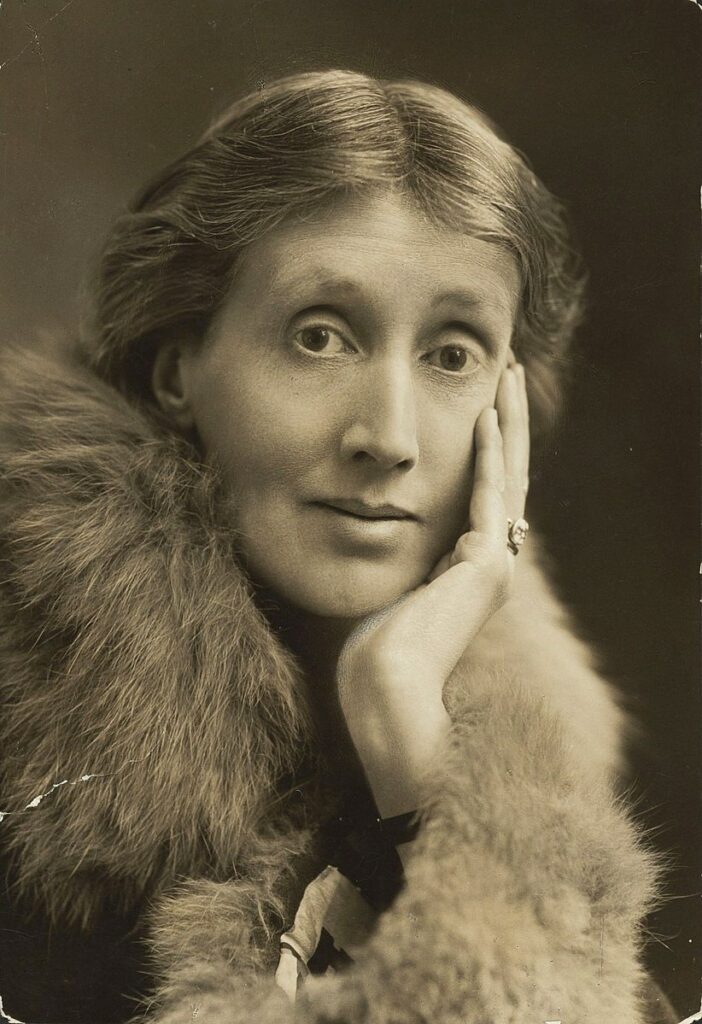Virginia Woolf, wearing a fur stole. Public domain, courtesy of wikimedia commons.
On August 3, 1917, Virginia Woolf wrote in her diary for the first time in two years—a small notebook, roughly the size of the palm of her hand. It was a Friday, the start of the bank holiday, and she had traveled from London to Asheham, her rented house in rural Sussex, with her husband, Leonard. For the first time in days, it had stopped raining, and so she “walked out from Lewes.” There were “men mending the wall & roof” of the house, and Will, the gardener, had “dug up the bed in front, leaving only one dahlia.” Finally, “bees in attic chimney.”
It is a stilted beginning, and yet with each entry, her diary gains in confidence. Soon, Woolf establishes a pattern. First, she notes the weather, and her walk—to the post, or to fetch the milk, or up onto the Downs. There, she takes down the number of mushrooms she finds—“almost a record find,” or “enough for a dish”—and of the insects she has seen: “3 perfect peacock butterflies, 1 silver washed frit; besides innumerable blues feeding on dung.” She notices butterflies in particular: painted ladies, clouded yellows, fritillaries, blues. She is blasé in her records of nature’s more gruesome sights—“the spine & red legs of a bird, just devoured by a hawk,” or a “chicken in a parcel, found dead in the nettles, head wrung off.” There is human violence, too. From the tops of the Downs, she listens to the guns as they sound from France, and watches German prisoners at work in the fields, who use “a great brown jug for their tea.” Home again, and she reports any visitors, or whether she has done gardening or reading or sewing. Lastly, she makes a note about rationing, taking stock of the larder: “eggs 2/9 doz. From Mrs Attfield,” or “sausages here come in.”
Though Woolf, then thirty-five, shared the lease of Asheham with her sister, the painter Vanessa Bell (who went there for weekend parties), for her, the house had always been a place for convalescence. Following her marriage to Leonard in 1912, she entered a long tunnel of illness—a series of breakdowns during which she refused to eat, talked wildly, and attempted suicide. She spent long periods at a nursing home in Twickenham before being brought to Asheham with a nurse to recover. At the house, Leonard presided over a strict routine, in which Virginia was permitted to write letters—“only to the end of the page, Mrs Woolf,” as she reported to her friend Margaret Llewelyn Davies—and to take short walks “in a kind of nightgown.” She had been too ill to pay much attention to the publication of her first novel, The Voyage Out, in 1915, or to take notice of the war. “Its very like living at the bottom of the sea being here,” she wrote to a friend in early 1914, as Bloomsbury scattered. “One sometimes hears rumours of what is going on overhead.”
In the writing about Woolf’s life, the wartime summers at Asheham tend to be disregarded. They are quickly overtaken by her time in London, the emergence of the Hogarth Press, and the radical new direction she took in her work, when her first novels—awkward set-pieces of Edwardian realism—would give way to the experimentalism of Jacob’s Room and Mrs. Dalloway. And yet during these summers, Woolf was at a threshold in her life and work. Her small diary is the most detailed account we have of her days during the summers of 1917 and 1918, when she was walking, reading, recovering, looking. It is a bridge between two periods in her work and also between illness and health, writing and not writing, looking and feeling. Unpacking each entry, we can see the richness of her daily life, the quiet repetition of her activities and pleasures. There is no shortage of drama: a puncture to her bicycle, a biting dog, the question of whether there will be enough sugar for jam. She rarely uses the unruly “I,” although occasionally we glimpse her, planting a bulb or leaving her mackintosh in a hedge. Mostly she records things she can see or hear or touch. Having been ill, she is nurturing a convalescent quality of attention, using her diary’s economical form, its domestic subject matter, to tether herself to the world. “Happiness is,” she writes later, in 1925, “to have a little string onto which things will attach themselves.” At Asheham, she strings one paragraph after another; a way of watching the days accrue. And as she recovers, things attach themselves: bicycles, rubber boots, dahlias, eggs.
Copyright
© The Paris Review








